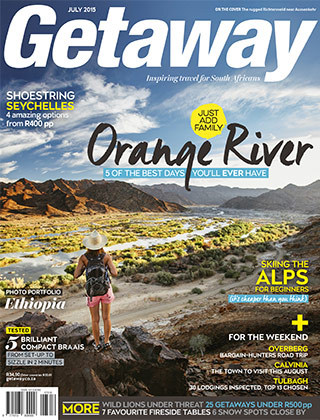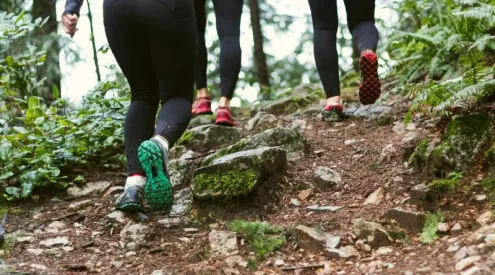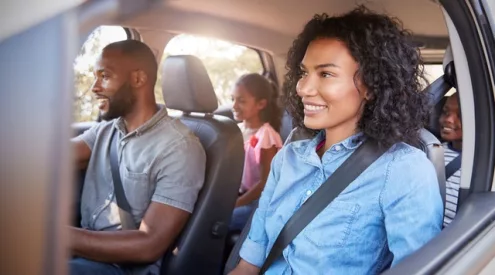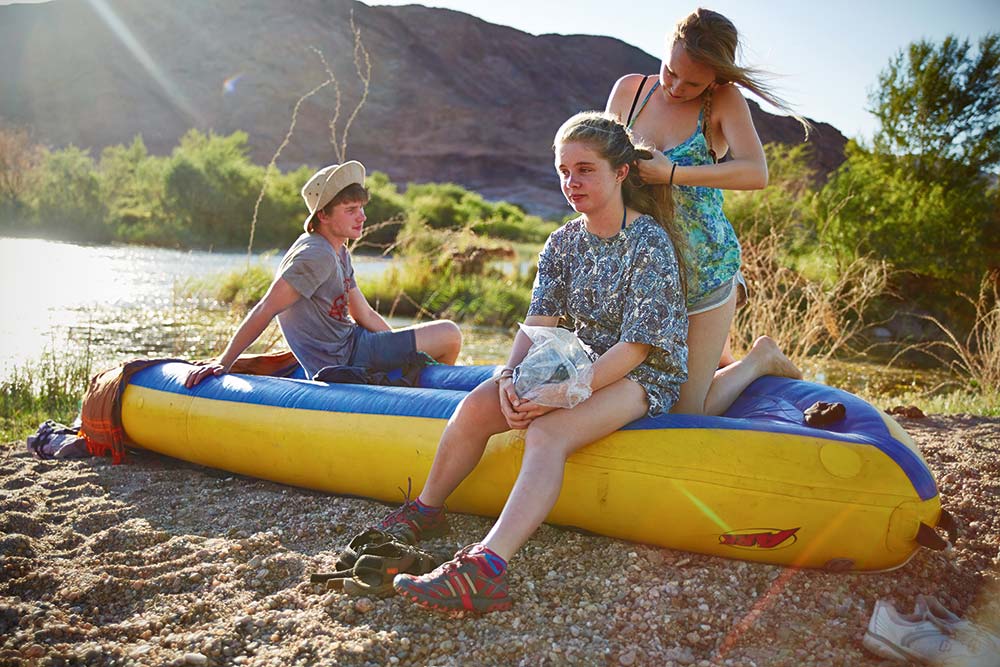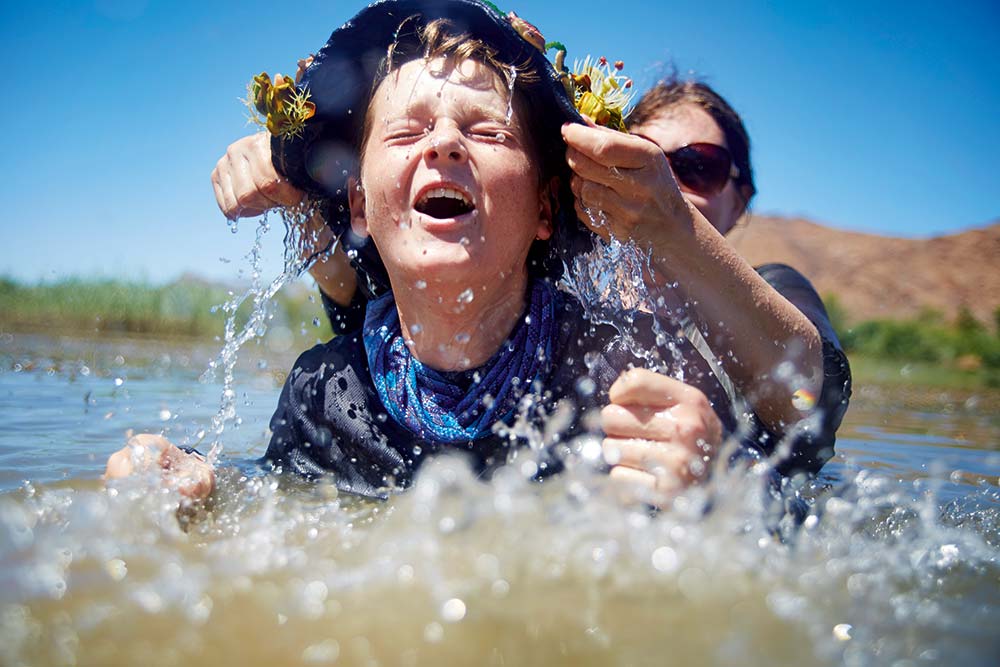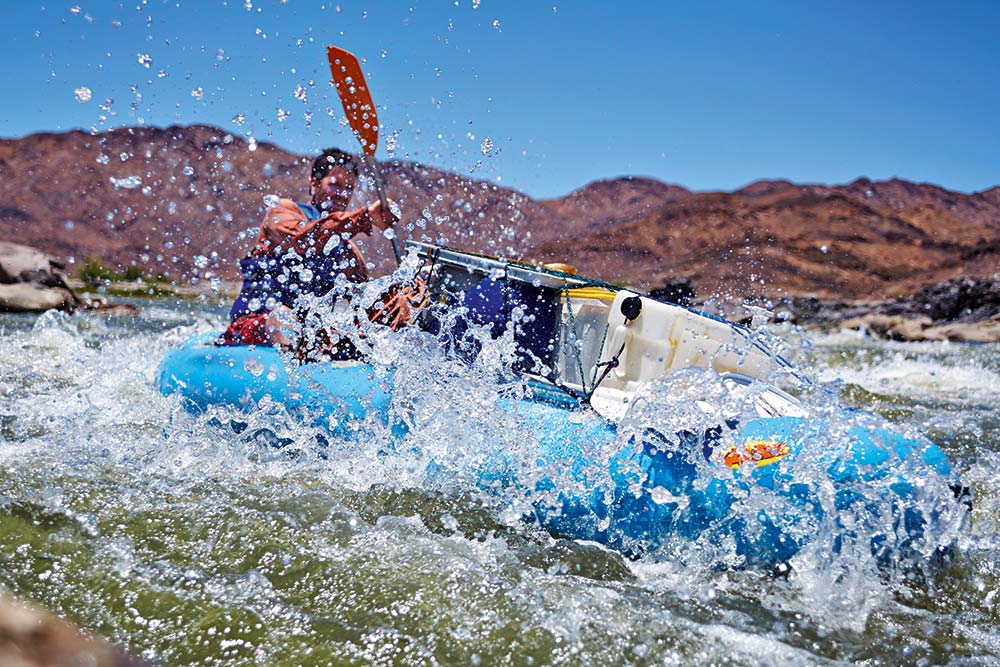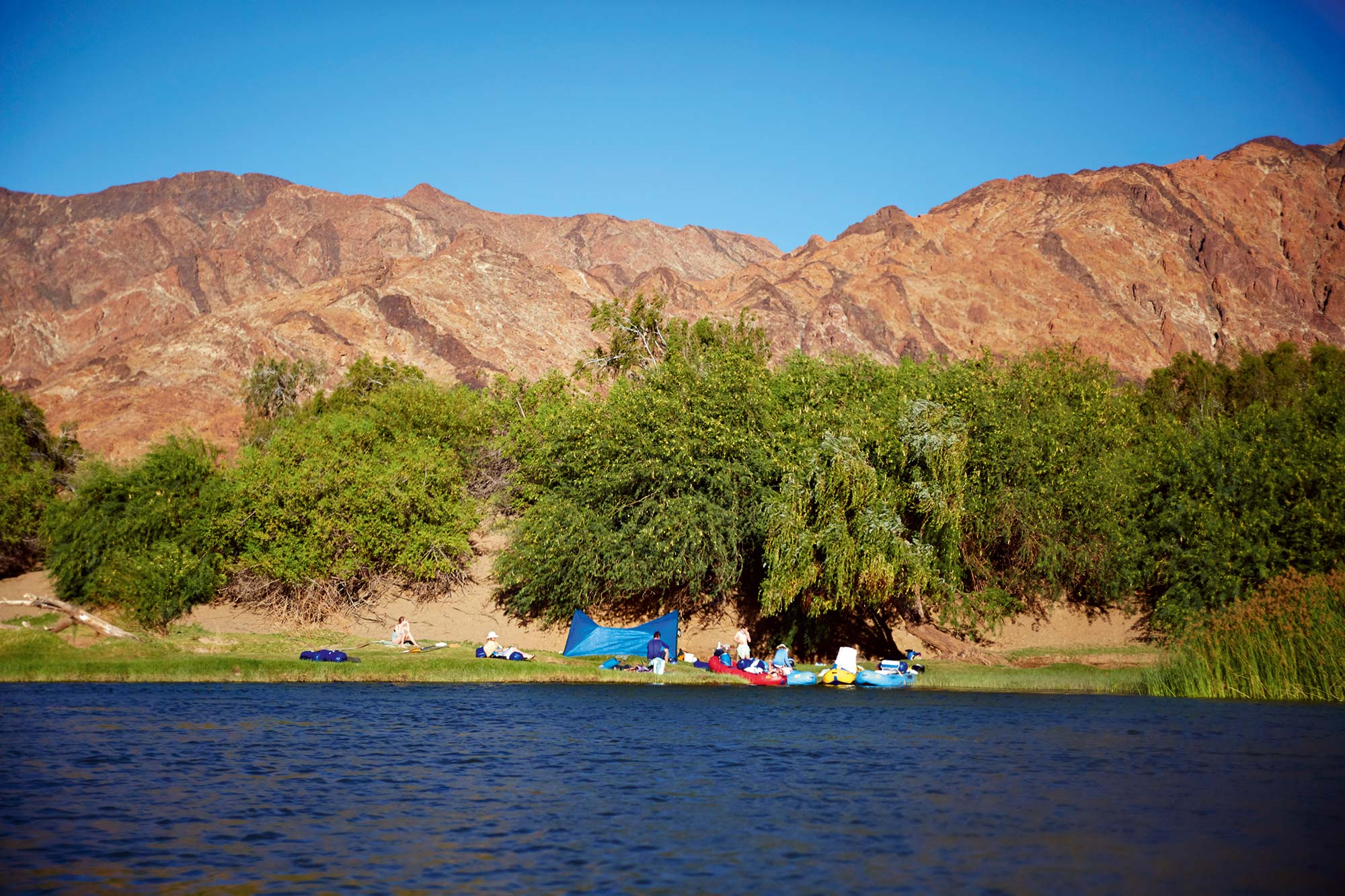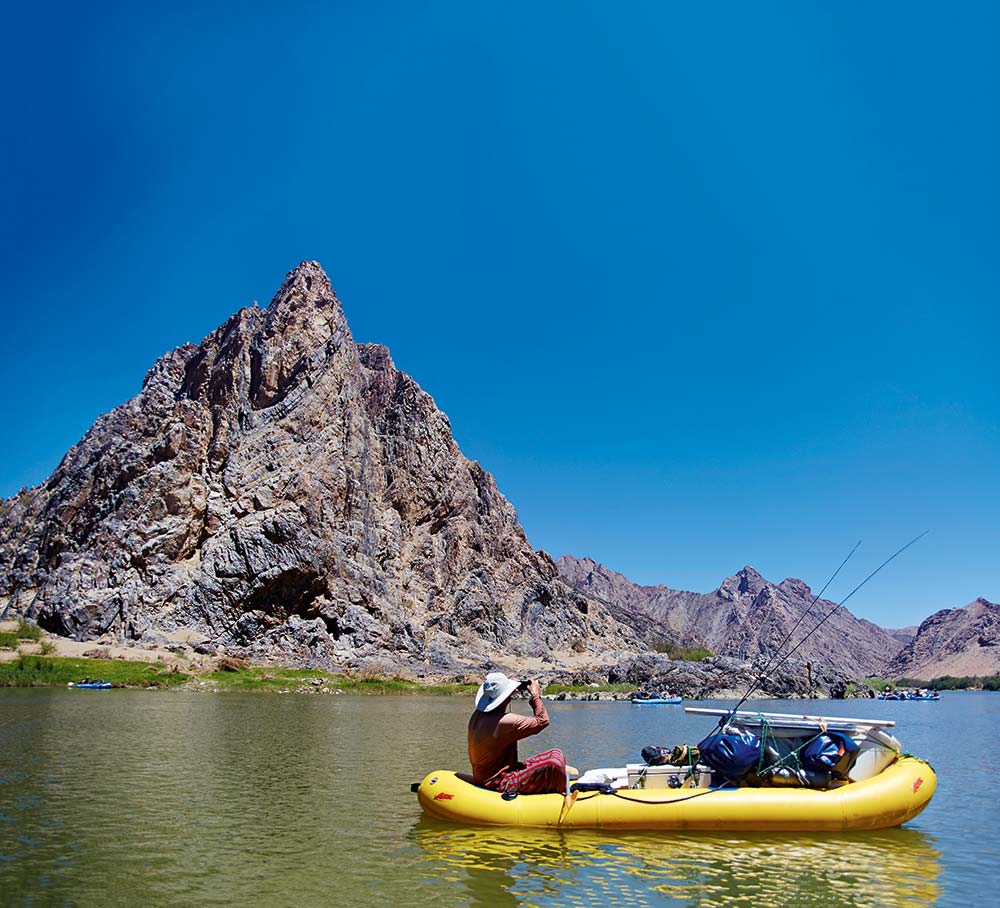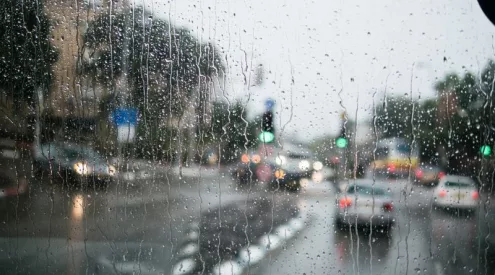James and Chris were 18 when they were kings of the river – guides in charge of taking groups down the Orange River. Now almost 50, the two men take their families back down that beloved body of water in an action-packed trip full of fun, and find it’s definitely one of the greatest family-friendly holidays in the world. Words by Chris Park. Photographs by Jessica Zumpfe.
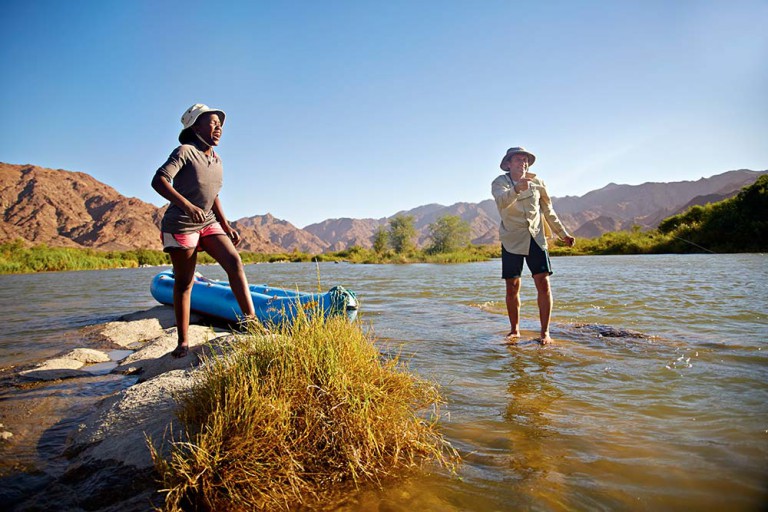
Big James, with his daughter Amy, fishing during the evening from a tiny island in the middle of the Orange River – the river most beloved by many South African families.
‘Dad-dad-dad!’ yells my son Little James as he paddles up behind me after just 20 minutes on the first day of our Orange River trip. ‘This is the BEST thing I’ve EVER done.’ His eyes are shining like buttons, his arms a blur of speed-paddling and he can hardly keep his bum on his seat for the sheer thrill of the thing. In front of him sits his 14-year-old paddling partner Sophia, a gleeful smile spreading across her face as big as the Richtersveld sky…
What a perfect start to our much-anticipated trip. And so, with a certain inevitability, I paddle up to the pair a bit later as the head wind begins to stiffen. ‘Daaaaad. Daaaaad. Daaaad,’ comes the plaintive voice. ‘I’m tired. Is it like this for FIVE days?’ There it is. Within 120 minutes of being on the river we have witnessed the full cycle of human emotion – from complete elation to devastating defeat. It’s the first of many lessons over the coming days, not all of them learnt by children.

Little James getting a hat filled with water plonked on his head by his mother, Katherine.
Indeed, the first lesson is mine and it’s brought on by the fact that I’ve not been down the Orange for 20 years. Yet I’m about to lead my family and two other families down here. I’m also 30 kilograms fuller than back in my heyday when I ran groups of 60 people in peak season without breaking a sweat. Am I up to this? Can I guarantee our safety? I imagine the headline, ‘Ex-river guide in Orange River family horror.’ Such is the anxiety that comes with adult life. We have become so invested in ourselves and our families that we fear loss and we shy away from risk. We question our own strengths.
Fortunately, into this quivering pit of self-doubt steps my dear old friend Big James. We first met when we were strapping young graduates running rivers. He still has the rosy cheer he used to bring to every trip he ever ran. We used to call him Smiler, ’cos he was such a friendly fella.
But despite his positive attitude he has also not been here for 20 years. So we’ve both forgotten large parts of the river. Such as Day 1 after lunch: do we go left or right at the deltas? And Day 2: a total blank except that we sleep somewhere above the looming Sjambok Rapid which has grown into a child-eating monster in our imaginations.
Big James reminds me that he once led a school trip here where few of the kids had ever swum before; that sometimes we had to guide dazed middle-managers on corporate trips who’d overdone it on cane and cola before breakfast; that we took six-year-olds down here without worrying; and that now strapping 12-year-old Little James was the youngest member of our 13-person party.

A typical load – clothes in a bucket strapped to the front, sleeping bags in a dry bag tied to the cool box.
All true and marginally reassuring, but not helpful when Little James and Sophia are being blown up-stream by the headwind. I encourage and cajole as I paddle the loaded cargo boat alone, and dip my head into the shoulder of the gale like an old familiar friend. As a guide you develop a relationship with wind because it can make or break a trip. You begin to sense how strong it is going to get. I used to talk to ‘The Wind’ and after many trips I believed I could talk it down. But I have lost my touch, so I paddle beside Little James and Sophia and feed them sweets.
We are tired when we get to camp late that first afternoon. The wind has not stopped and when we finally roll into Camp Hammerkop – it’s not as pretty and protected as Big James and I remember. Turns out the camp was washed away by the flood of 2011. But we’re too tired to continue, so we camp on a dune and braai with sand whirling around our over-priced steaks. And when we collapse into bed under the stars we have sand in our teeth and stuck to our skulls.
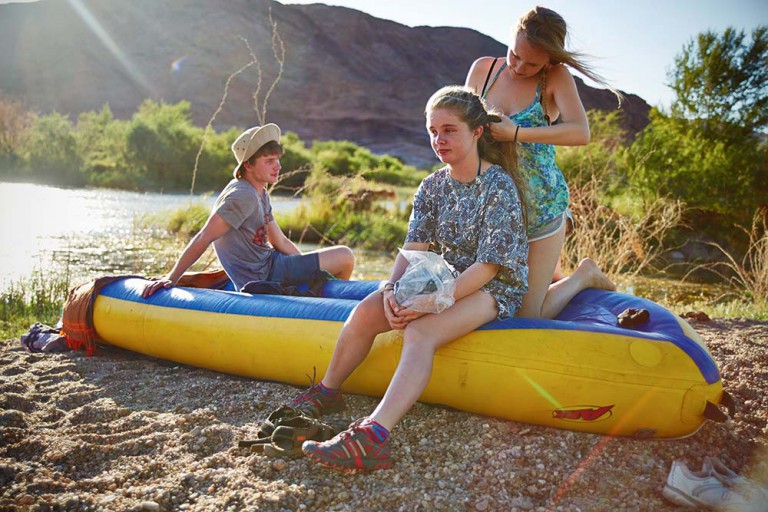
That’s my darling daughter Julia plaiting and grooming Tess, while Ben looks on. The advantage of taking inflatable canoes or crocs is that you sleep on them upturned (like this one) every night.
We wake in the morning on Day 2 to a windless, crystal-clear orange world. We are dwarfed as we lie there in our rows of sleeping bags laid out like cocoons beside the quiet river that slides past. All around us are giant brown/red/yellow/maroon/black mountains, their peaks dipped in the early morning sun. Gradually we emerge and some of us stand in a dozy line alongside the river and stretch our stiff arms, shoulders, backs, bellies. We have breakfast quietly, in awe of these gnarly, echoing peaks.
‘Anything more for Ben’s boat?’ yells Big James as we pack the last few boats before heading off. Ben is our strapping water polo-playing matriculant who’s paddling our cargo boat and by the time we’re done it is so heavy it lilts in the water like a drunken hippo. Big James and I smile at each other because we know he will work hard today. Then we look at Ben with envy – that perfect specimen, a reminder of our former selves.
In the course of the morning Big James and I begin to recognise the river. It’s like déjà vu – both familiar and new. The river here has narrow channels of fast flowing water and by 11am the kids are over-board: lifejackets on, hanging onto their boats, their sun-creamed faces full of delight as the cool liquid carries them swiftly downstream.
There is no other human in sight and suddenly our sheer isolation sets in – three families alone in a vast, other-worldly world. Somehow, without our normal work pressures or teenage school angst or endless lifting or phones beeping, we begin to let ourselves go.
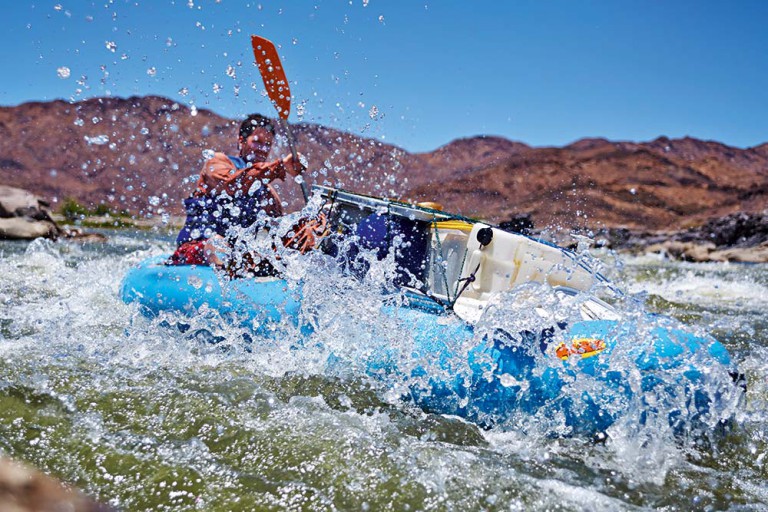
Andrew coming through the last big wave on Sjambok rapid in a cargo boat. Photo by Jessica Zumpfe.
It’s in this slightly elevated state that we link all eight boats together side by side and head towards an upcoming rapid. Everyone begins shrieking incoherent instructions and nobody is listening so I relinquish all responsibility and cast my gaze across the eight boats. The children’s responses tell a story: Amy (12) with a quiet, mischievous smile; Ben (18) in cantankerous mood, yelling orders and yet refusing to participate; Sophia (14) undone by her own spontaneous laughter; Julia (19) serenely shaking her head; Tess (14) half-giggling, half-crying with anticipation; Little James (12) on his back, both legs kicking in the air in wild hysterics.
In this messy state of disrepair we shoot the harmless rapid and pull up onto a grassy bank for lunch. I do not feel like making lunch. I am tired and so is Big James. This is harder work than we remember, so we encourage our offspring to prepare food. Now, one of the things about being a father is that your children, especially when in such a Champagne mood, tend to show you little of the respect you so richly deserve. So following our request for help, their mocking comments come thick and fast: ‘Oh you geniuses, forgotten where you packed the lunch already?’ or ‘Oh Dad, too old for a little heavy lifting?’, and even ‘Oh shame Dada, he needs his afternoon nap.’
We have lunch a little late that day. Afterwards Big James and I take a nap.
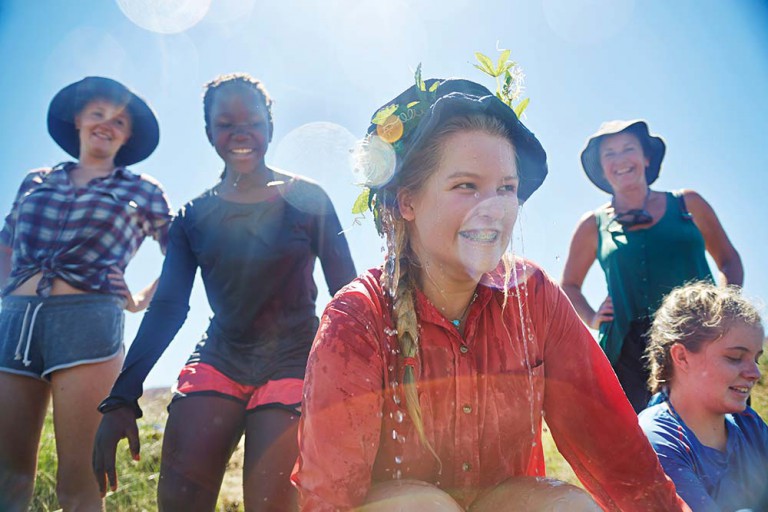
Sophia in the middle of a water fight, behind her from left is Julia, Amy and Aunt Veronica.
At the end of that afternoon’s paddling we stop and prepare to sleep on an island in the middle of the river. It feels like no-one has ever slept here before and we notice our children are starting to turn a little wild. They regard this as no-man’s land – an isolated island somewhere between Namibia and South Africa, not governed by anyone and far from the rule of law.
They are further inspired towards delinquency by the story of old Gerrie, a bearded man Big James and I used to see down here occasionally two decades ago. Like many stories told in lonely desert towns, his life was the stuff of myth; he was said to be on the run from the law and he lived alone on one of these islands with his typewriter, his canoe and his conspiracy theories. He would appear sometimes like a troll from behind the reeds in search of sugar, wine and women.
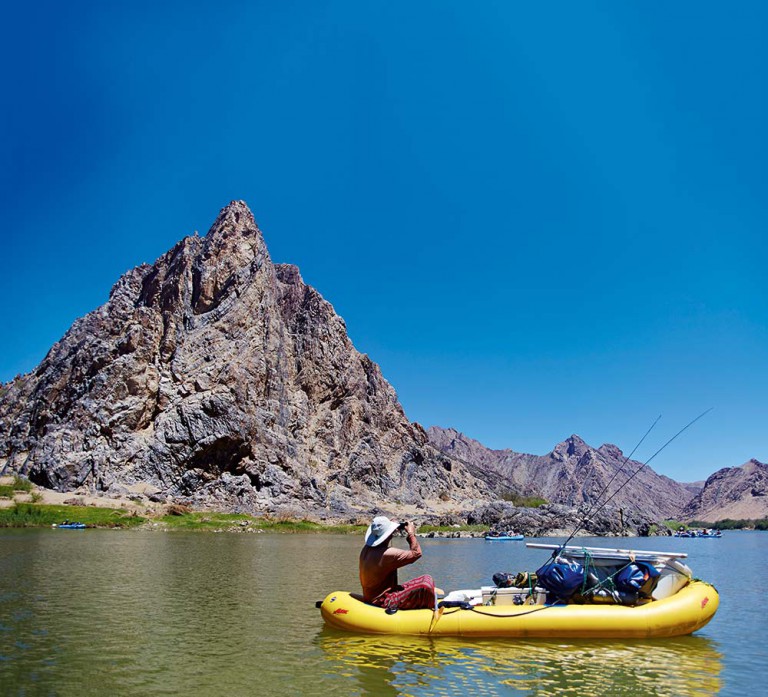
If you take an extra day on this trip, you find plenty of time to relax. Here Andrew and his fly rods float below the zig-zag folds of Witches Hat Mountain.
To calm the feral children, we order them into their boats and paddle from our island republic to Namibia and walk them sternly into the desert. We head up and out of the valley to an old fluorspar mine. Standing up there you feel like you’re on top of the world. You look out over a great sweep of the river and onto one of the oldest pieces of exposed earth on the planet that dates back 2000-million years, almost half the age of the earth itself. From here you can see the stripes of hard black basalt rock forced up when the Earth’s crust cracked and the super-continent Gondwanaland broke up. These stripes now form a spine that runs across the Richtersveld from north to south for more than 100 kilometres.
That night we throw fluorspar hacked from the mine onto the coals of our fire and watch them glow luminous green and explode. We fall asleep to the sounds of Katharine, with her perfect pitch, singing to us. We sleep like babies on our soft green grassy island.
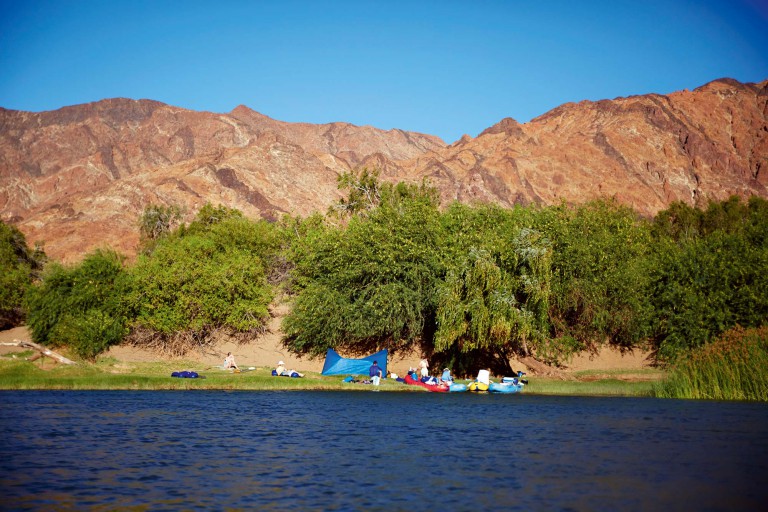
On Day 3, our camp under the biggest Rhus tree in sight. We slept out in the open every night.
Big James and I are up early next morning preparing for Sjambok. We tie every boat meticulously.
‘That’s serious tying,’ says fellow dad Andrew discreetly. ‘Should I be worried?’ He’s a shrink, he can sense tension a mile away.
Sjambok, like Gerrie, has many stories. But Big James and I have both seen the power of these currents that swirl beneath your boat. To the untrained eye it looks like another fun rapid with a big wave at the bottom. But when the water’s high it becomes a boiling cauldron as the entire river is channelled into a narrow six-metre wide shoot.
‘We don’t need to be worried,’ says Big James, ‘but it’s different taking clients down when you are 23 and taking your own kids down now. I feel protective.’
‘So is it tougher than other white water you’ve paddled?’ asks Andrew.
‘No, we just don’t want a swimmer,’ I say. And there it is: no swimmers allowed. So we put one strong paddler on each boat and after a stern talk about keeping the right line, we set off.
I stand with a rescue bag at the bottom of the rapid and watch with a pounding heart as each boat comes through wide-eyed and whooping. It’s a near-perfect run and in the calm that comes after an adrenaline high we drift down on a welcome tail wind, Big James and I relieved to have it behind us. By 2pm we are off the river and we spend the afternoon fly fishing, collecting precious stones, reading books, talking rubbish.
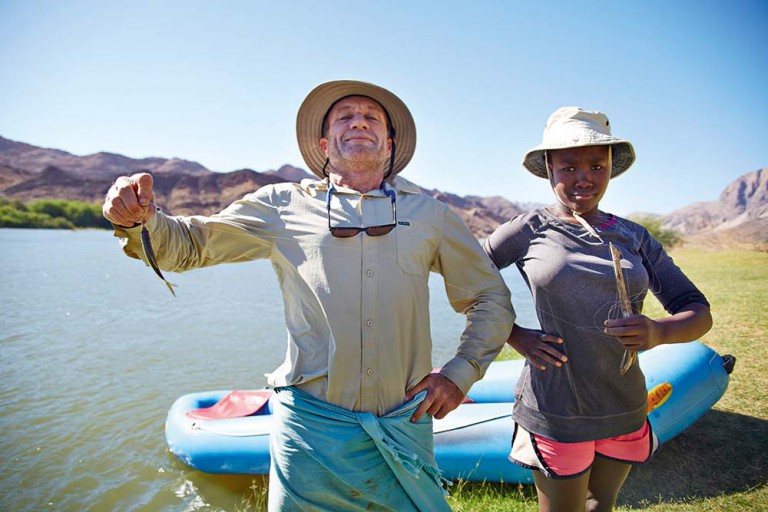
Triumphant Big James and Amy with their vanquished fish.
Big James makes a huge fuss when he catches a fish the size of his baby finger. Then he pulls in a real fish, a 50-centimetre yellowfish.
‘What a beauty,’ I yell as he holds it up. ‘Was it a good fight?’
‘Yes,’ he says triumphantly, ‘it was a great fight.’
‘Only because you won it,’ says his daughter Amy, deadpan.
We look at each other and chuckle.
It’s hard to imagine that wise little Amy and the rest of our progeny were not yet born when we last visited this place. So much has changed in our lives. But so little has changed for the Orange River. Here, aside from a few river banks being washed away, the great silent walls of rock still stare back at you and say: ‘You, my friend, are a grain of sand.’
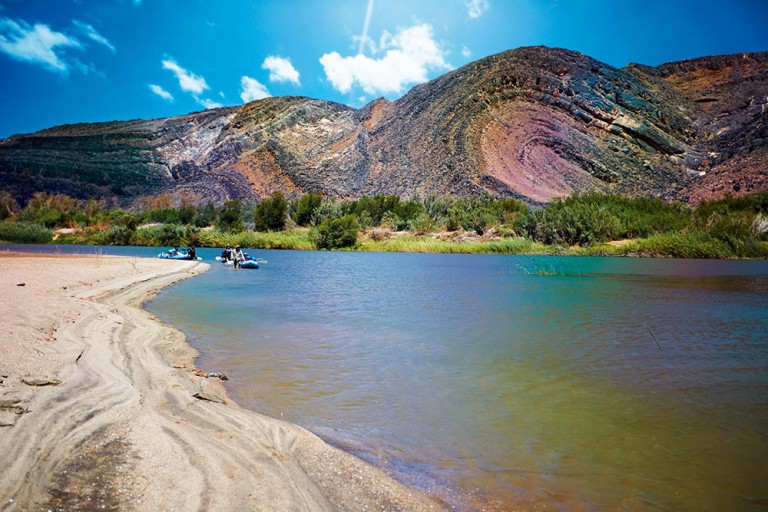
Thumbprint is one of the landmarks on the river, where you first begin to realise just how huge and very, very old this place is.
Five tips for a perfect family trip
- If you have never done an Orange River trip, book now – it’s one of the greatest pieces of family-friendly travel in the world.
- Only go in mid-summer if you love the heat.
- Go with enough friends to make up your own group – in season you need 20 people. During off season you can easily negotiate with a river company to make up your own party of about eight people.
- You will drink less alcohol than you think. Take lots of Game isotonic drink. In mid-summer rehydrate after lunch every day.
- Split paddlers up each day, but make sure you have one stronger paddler in each boat.
What you should know about a family trip to the Orange River
Is it safe for families?
Yes, it always has been. Guides are well trained to deal with any issues of river safety and first aid.
Which company should you go with?
Amanzi Trails River Adventures is very established, with a wonderful leafy camp and you can choose to go on canoes or inflatables.
Bushwacked Outdoor Adventures is low key and has lovely rustic camps. I have not joined one of its trips but the owner has been in the game for more than 20 years and is very experienced.
Other operators include Bundi, Felix Unite, Gravity Adventures and River Rafters, Umkulu Adventures.
Canoes or inflatables?
Canoes are more of a challenge in the rapids and so lots of fun. They are also better on the flat sections because they go faster. Inflatable canoes or crocs make for a more chilled experience – easier on the rapids, more manoeuvrable, more comfortable. If you go in crocs you are slower, so get your host company to add a night to the trip unless the river is high.
Is the river overrun with other people?
Amazingly not. There were four other trips that started on the same day as we did and we hardly saw them.
Is there lots of litter on the river?
That was the one thing we feared, but we found the river cleaner in all ways than 20 years ago. Plus campsites were spotless. Impressive.
Which campsites should we stop at?
It all depends on how many other trips there are on the same stretch. Campsites can be at a premium when the river is busy and you take what you can get. But each company and guide has favourite spots. You can’t book them, and really only the guides know the names of each camp.
What about food?
The catering is different for every company. Our menu was simple: fruit, cereal and toast for breakfast; lunch, elaborate sarmies and salads; supper, a mix of braai and fire bakes and spaghetti Bolognese with nice salads. Lots of choc for the eve. Always good to have snacks for the evening when you get off the river before supper, and on the river during the day.
When should I book an Orange River trip?
The best times to go are autumn and spring, but those are also the busiest times, when you can have eight trips starting on the river every day. Over New Year it also gets busy and there are big parties at the camps. Peak season is Easter weekend and September school holidays. The river gets very full at those times, but if you start a day or two earlier or later, you miss the rush, so you might need to take your kids out of school for a day. If you don’t book ahead, you could lose these prime spots.
How much will it cost?
About R3000 per adult for four nights, all inclusive except snacks, drinks and transport to and from base camp.
This article first appeared in the July 2015 issue of Getaway magazine.
All prices were correct at time of publication, but are subject to change at each establishment’s discretion. Please check with them before travelling.
